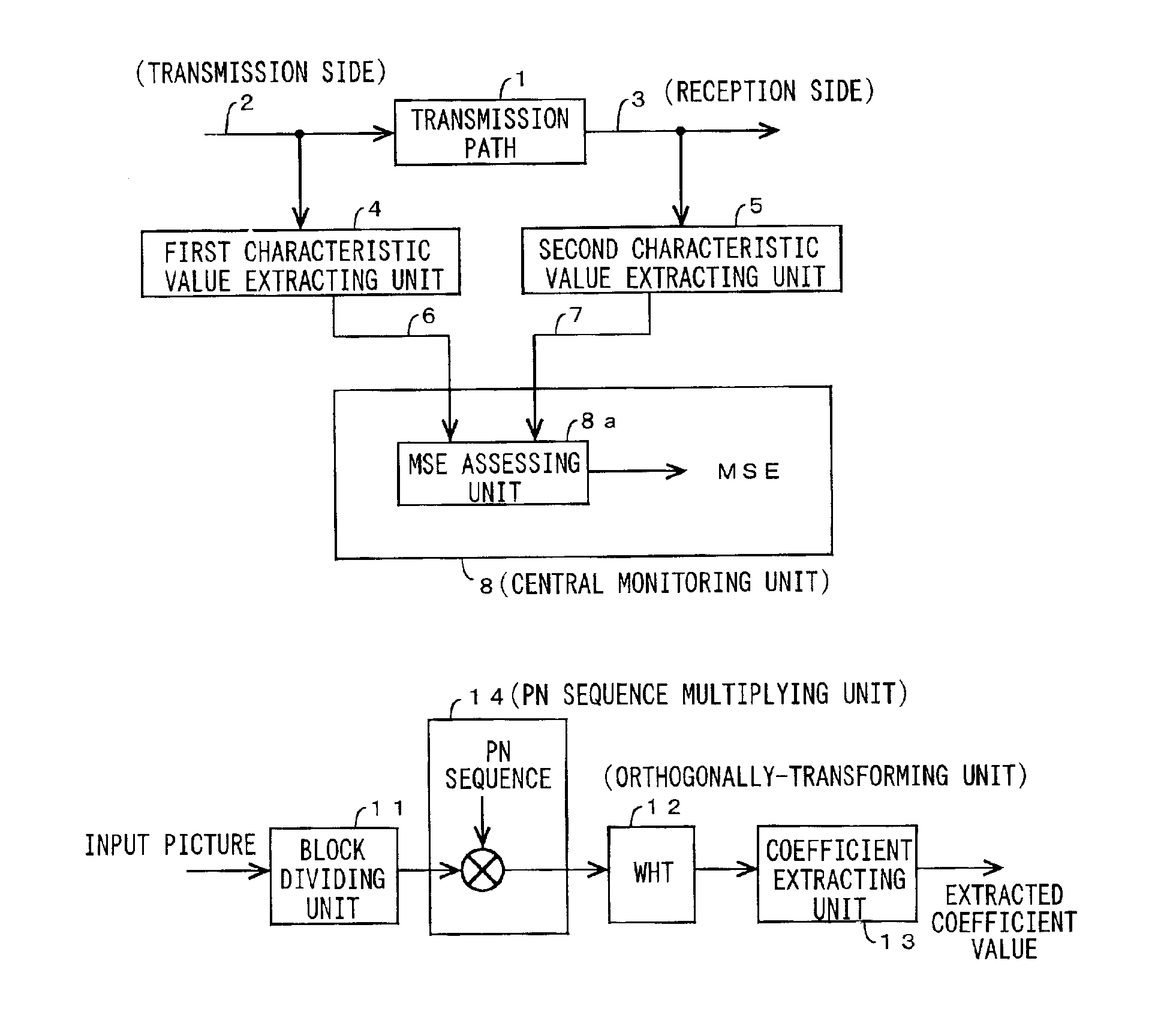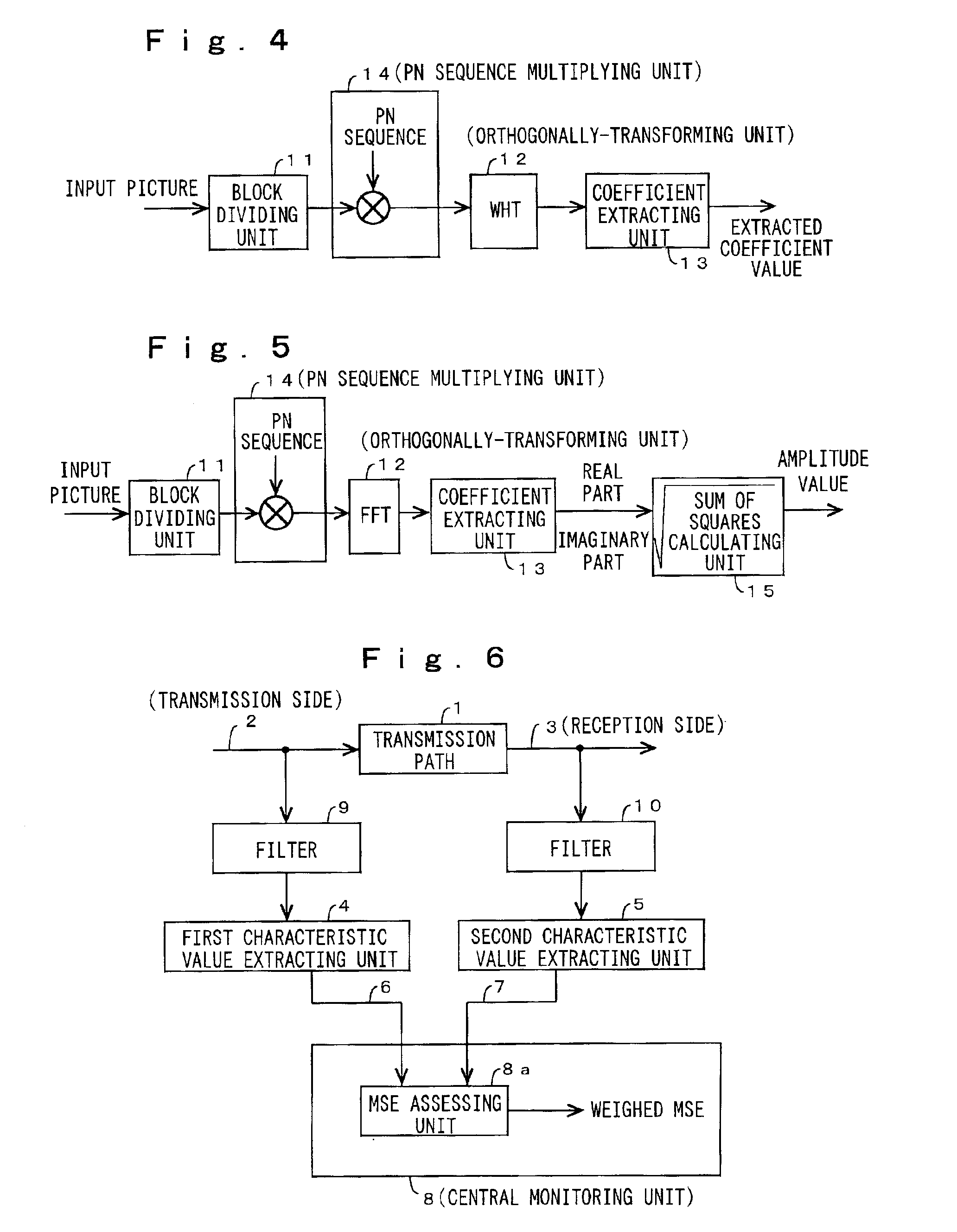Apparatus for monitoring quality of picture in transmission
a technology for transmission and apparatus, applied in the field of apparatus for monitoring the quality of a picture in transmission, can solve the problems of low principled accuracy of the assessment method and the inability to use the above method in the actual field of picture transmission, and achieve the effect of effective assessment of the ms
- Summary
- Abstract
- Description
- Claims
- Application Information
AI Technical Summary
Benefits of technology
Problems solved by technology
Method used
Image
Examples
first embodiment
[0035]The present invention will be described below in detail with reference to the drawings. FIG. 1 is a block diagram showing the schematic arrangement of the present invention applied to a system (referred to as a picture transmission chain) in which a plurality of transmission processing devices are connected in series to a transmission path. FIG. 1 shows an arrangement of a portion of the picture transmission chain.
[0036]In FIG. 1, a picture or video picture is transmitted from a transmission side 2 to a reception side 3 through a transmission path 1. A first characteristic value extracting unit 4 extracts the characteristic value of the picture transmitted from the transmission side 2. In contrast, a second characteristic value extracting unit 5 extracts the characteristic value of the picture received on the reception side 3. The characteristic values extracted by the first and second characteristic value extracting units 4 and 5 are supplied to a central monitoring unit 8 th...
second embodiment
[0054]Next, the present invention will be described with reference to FIG. 4. FIG. 4 is a block diagram showing a specific arrangement of the first and second characteristic value extracting units 4 and 5.
[0055]In FIG. 4, first, an input picture is supplied to a block dividing unit 11 and divided into blocks. However, the “block” is defined as described above. Next, the signals in the blocks are subjected to spectrum spreading in a PN sequence multiplying unit 14. That is, the blocks are multiplied by a PN sequence. The PN sequence may be any arbitrary sequence of numbers in which +1 and −1 are generated at random (such as +1, +1, −1, +1, −1, −1, +1, −1, +1, . . . ). Thereafter, the resultant blocks are subjected to Walsh Hadamard transformation (hereinafter, abbreviated as “WHT”). In a picture G having a block size of, for example, 8×8, the WHT is shown by α as shown below.
α=UGU U=[111111111111-1-1-1-111-1-1-1-11111-1-111-1-11-1-111-1-111-1-11-111-11-11-1-11-111-11-11-11-1]
α shows ...
third embodiment
[0060]Next, the present invention will be described with reference to FIG. 5. FIG. 5 is a block diagram showing a third specific arrangement of the first and second characteristic value extracting units 4 and 5.
[0061]FIG. 5 is different from FIG. 4 in that a Fourier transformation FFT is used as an orthogonally-transforming unit 12 and that a sum of squares calculating unit 15 is disposed behind a coefficient extracting unit 13. In FIG. 5, the same reference numerals as those used in FIG. 4 denote the same components or similar components.
[0062]A first feature of the third embodiment resides in that the Fourier transformation FFT is used as the orthogonally-transforming unit 12. The Fourier transformation FFT is a most precise and appropriate method of transformation physically in the meaning of frequency spectrum. This is a merit of using the Fourier transformation as the orthogonal transformation. Note that, to realize the third embodiment, it is appropriate to make use of high sp...
PUM
 Login to View More
Login to View More Abstract
Description
Claims
Application Information
 Login to View More
Login to View More - R&D
- Intellectual Property
- Life Sciences
- Materials
- Tech Scout
- Unparalleled Data Quality
- Higher Quality Content
- 60% Fewer Hallucinations
Browse by: Latest US Patents, China's latest patents, Technical Efficacy Thesaurus, Application Domain, Technology Topic, Popular Technical Reports.
© 2025 PatSnap. All rights reserved.Legal|Privacy policy|Modern Slavery Act Transparency Statement|Sitemap|About US| Contact US: help@patsnap.com



